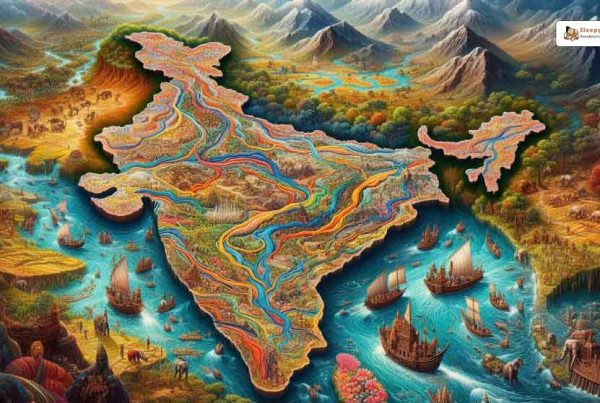The theory of continental drift, first proposed by Alfred Wegener, revolutionized our understanding of Earth’s geological history. Wegener suggested that continents were once part of a supercontinent called Pangaea, which gradually broke apart due to various forces. This theory laid the groundwork for the development of plate tectonics, which provides a comprehensive explanation for the distribution of continents and oceans today. Let’s delve into the key aspects of these theories and their implications for our understanding of Earth’s dynamic nature.
Key Takeaways
- Continental drift theory was first proposed by Alfred Wegener.
- Pangaea was a supercontinent that existed millions of years ago.
- Plate tectonics theory explains the movement of Earth’s lithospheric plates.
- Evidence for these theories includes matching coastlines, fossil distribution, and geological formations.
- Modern studies continue to refine our understanding of these processes.
Continental Drift Theory
The continental drift theory posits that continents have moved over geological time and were once joined together in a supercontinent called Pangaea. This supercontinent began to break apart due to certain forces, leading to the formation of the continents and oceans as we know them today. Wegener’s theory was based on several lines of evidence, including the apparent fit of the coastlines of South America and Africa, the distribution of fossils, and geological similarities between distant continents.
Evidence Supporting Continental Drift
- Matching Coastlines: The coastlines of South America and Africa appear to fit together like pieces of a jigsaw puzzle, suggesting they were once joined.
- Fossil Distribution: Similar fossils have been found on continents that are now widely separated by oceans, indicating they were once connected.
- Geological Formations: Mountain ranges and rock formations on different continents show remarkable similarities, further supporting the idea of a once-unified landmass.
- Glacial Deposits: Evidence of past glaciation in now-tropical regions suggests these areas were once located closer to the poles.
Forces Behind Continental Drift
Wegener proposed two main forces responsible for continental drift:
- Pole-Fleeing Force: This force is related to the Earth’s rotation and the centrifugal force that pushes continents away from the poles.
- Tidal Force: The gravitational pull of the moon and the sun creates tidal forces that could contribute to the movement of continents over long periods.
Criticisms of Continental Drift Theory
Despite its groundbreaking nature, Wegener’s theory faced several criticisms:
- Lack of Mechanism: Wegener could not provide a convincing mechanism for the forces driving continental drift.
- Exclusion of Oceans: The theory primarily focused on continents and did not adequately explain the role of oceans in the process.
- Empirical Evidence: Some of the evidence Wegener used was considered circumstantial and not robust enough to convince the scientific community at the time.
Plate Tectonics Theory
The theory of plate tectonics, developed in the mid-20th century, built upon Wegener’s ideas and provided a more comprehensive explanation for the movement of Earth’s lithospheric plates. According to this theory, the Earth’s lithosphere is divided into several plates that float on the semi-fluid asthenosphere beneath. These plates move due to convection currents in the mantle, leading to various geological phenomena such as earthquakes, volcanic activity, and the formation of mountain ranges.
Types of Plate Boundaries
- Divergent Boundaries: Plates move away from each other, leading to the formation of new crust. Example: Mid-Atlantic Ridge.
- Convergent Boundaries: Plates move towards each other, resulting in subduction or continental collision. Example: Himalayas.
- Transform Boundaries: Plates slide past each other, causing earthquakes. Example: San Andreas Fault.
Evidence Supporting Plate Tectonics
- Seafloor Spreading: The discovery of mid-ocean ridges and the symmetrical age of rocks on either side provided strong evidence for seafloor spreading.
- Magnetic Stripes: Patterns of magnetic stripes on the ocean floor indicate periodic reversals of Earth’s magnetic field, supporting the idea of seafloor spreading.
- Distribution of Earthquakes and Volcanoes: The global distribution of earthquakes and volcanic activity aligns with plate boundaries, supporting the theory of plate tectonics.
- Fossil and Geological Correlation: Similar to continental drift, the distribution of fossils and geological formations across continents supports the movement of plates.
Modern Studies and Updates
Recent studies have continued to refine our understanding of plate tectonics and continental drift. For example, research has shown that the rate of seafloor spreading has slowed by about 35% globally. This finding has implications for our understanding of the forces driving plate movements and the future configuration of continents and oceans.
Conclusion
The theories of continental drift and plate tectonics have profoundly shaped our understanding of Earth’s geological history. While Wegener’s continental drift theory faced initial skepticism, it laid the foundation for the more comprehensive plate tectonics theory. Together, these theories explain the dynamic nature of our planet, from the formation of mountain ranges to the occurrence of earthquakes and volcanic activity. Ongoing research continues to enhance our understanding of these processes, highlighting the ever-evolving nature of Earth’s surface.
For more informative blogs on UPSC preparation, Click Here!







